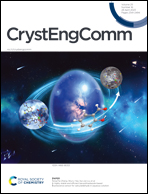Molecular dynamic simulations of the liquid structure and fast growth of Y3Al5O12†
Abstract
Due to yttrium aluminum garnet (YAG) having many excellent properties, investigation of the liquid structure of YAG at high temperatures is significant for numerous fields, including crystal nucleation, glass fabrication, and single-crystal growth. The structure of YAG within a certain temperature range, including the melting point, was studied by molecular dynamic simulations, and a YAG single crystal was rapidly grown. Compared with the YAG crystal, the coordination number of oxygen ions for both Al3+ and Y3+ dropped, and the bond length between the cations and anions shortened after melting. These two phenomena can be understood systematically within the framework of Pauling's third rule, and its universality has been verified in various oxide systems. In the liquid YAG, the coordination number decreased and the bond lengths between cations and anions reduced with the increase in temperature. Furthermore, the motifs in the melt were very different from those in the YAG crystal, and the main structural units in the melt were AlO4 and YO7. Based on the understanding of the structure of the YAG melt, an insight could be gained into the phase selection in the undercooled YAG melt, and a rapid pull-up growth of YAG was realized by using the Czochralski method.



 Please wait while we load your content...
Please wait while we load your content...